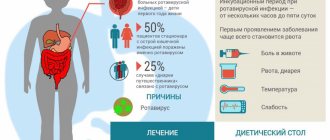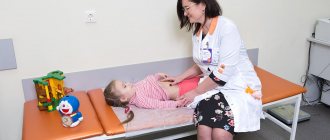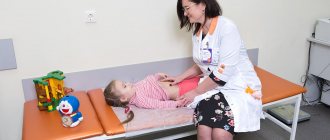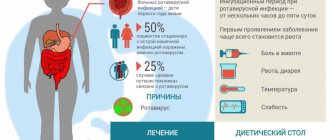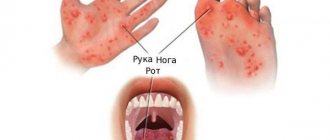The article was prepared by a specialist for informational purposes only. We urge you not to self-medicate. When the first symptoms appear, consult a doctor.
Rotavirus intestinal infection is an acute infectious disease that affects the human digestive system. In addition to the gastrointestinal tract, organs of the respiratory system may also be involved in the pathological process.
In adults, the disease is diagnosed less frequently than in children. However, cases of rotavirus infection in middle-aged and older people have been reported by doctors. Rotavirus infection is manifested by increased body temperature, redness of the throat, vomiting, abdominal pain, and diarrhea. Treatment for uncomplicated disease is carried out at home, but requires the implementation of some mandatory points, including: adequate rehydration, taking medications containing enzymes, enterosorbents. At the doctor's discretion, antiviral medications may be prescribed.
Rotavirus infection, due to its widespread distribution, is rightly called intestinal flu or cholera minor. Rotavirus infections are second only to ARVI in terms of prevalence. About 40% of all cases are newborns and children under 3 years of age. Every year, more than 600 thousand people worldwide die from the infection. As a person gets older, susceptibility to rotavirus infection decreases significantly, but the likelihood of the virus entering the body remains.
The disease is often characterized by outbreaks within one family or group. Therefore, if there is a sick child in the house, then with a high degree of probability the rest of the family members will get sick. However, in adults, the disease most often occurs in a mild form and does not require hospitalization.
Causes of rotavirus infection in adults
Rotavirus infection in an adult develops after a viral particle from the family Reoviridae, genus Rotavirus, enters his body. In the host body, the virus is capable of creating multiple combinations, which determines the wide strain diversity of rotaviruses that are released by a sick person into the external environment. However, more than 90% of all rotavirus infections in the world are accounted for by the following five strains: G1P8, G2P4, G4P8, G3P8, G9P8.
The source of spread of the disease is an infected person who releases the virus into the external environment along with feces. Virus shedding begins even before the infected person develops the first signs of the disease. A person remains contagious even after the main manifestations of the infection are stopped. This continues until the 20th day from the moment of infection.
Since rotavirus infection is a disease predominantly of children, it is children who infect adults. Most often this happens while parents are caring for their sick children. However, another source of spread of pathogenic microorganisms cannot be ruled out. Although cases of rotavirus infection are reported throughout the year, the peak of the disease occurs in spring and winter.
The main mechanism of infection transmission is fecal-oral. It can be implemented in various ways, among which the contact-household path prevails. The mass spread of the disease is caused by water and food transmission of the virus.
Regarding the question of the possibility of the virus spreading through the air (with dust or mucus particles), there is no consensus on this matter, and the question remains open.
So, rotavirus is an extremely contagious microorganism that can enter the external environment in only one way - with the feces of a sick person. Feces contain a huge amount of viruses, so they can easily end up on door handles, on a person’s hands, on his clothes, on household items, etc. From these surfaces, viruses are transferred to the oral cavity, through the digestive tract they reach the small intestine, as a result what causes the disease to develop. A very small amount of viruses is required for infection to occur. Therefore, if someone in the family has an intestinal infection, the likelihood of its spread is extremely high.
People in the following professions are at risk of contracting rotavirus infection: catering workers, educators and teachers, water utility workers, and salespeople. Therefore, you should not think that rotavirus infection is a childhood disease. There is a risk of infection throughout life. Viruses retain their vital activity during long-term freezing, but when boiled they quickly die. In the external environment, when in water, on food, in feces, viruses can live from 1 to 3 months. They exhibit moderate resistance to disinfectants.
Epidemiology
Rotavirus infection is a typical seasonal disease. According to statistics, in almost 93% of cases the disease develops in the winter months.
The infection often spreads in epidemic outbreaks - especially in kindergartens, hospitals, nursing homes and other institutions where children or adults with weakened immune systems are in close contact.
Children are most susceptible to infection. The share of rotavirus infection is 39.4% of all episodes of diarrhea under the age of 5 years.
Symptoms of rotavirus infection in adults
The incubation period does not take long. Most often it lasts from 15 hours to 5 days, but the average time for the first symptoms of the disease to manifest is 1-2 days after infection. The disease develops acutely, the peak manifestation of its symptoms is observed after 12 hours.
All symptoms of rotavirus infection in adults are much milder than in children.
If the disease has an uncomplicated course, it will be characterized by the following symptoms:
- Intoxication of the body may be absent or insignificant. This manifests itself in increasing weakness and deterioration of appetite.
- Body temperature rises, but rarely reaches febrile levels. Most often it remains within 38 °C. After a day, the hyperthermic reaction disappears.
- Diarrhea lasts from 3 days to a week. As a rule, it is limited to 5 episodes of loose stools per day, and may be accompanied by rumbling in the stomach.
- The stool takes on a mushy consistency.
- Abdominal pain is mild and occurs as spasms. They are localized mainly in the navel and epigastric region.
- Vomiting is most often absent, and can be one-time and moderate.
However, the disease does not always occur in adults in a mild form.
In some cases, the following symptoms may occur:
- Severe intoxication of the body. The person becomes lethargic, he develops pain and aches in the joints, sweating increases, his appetite disappears, and he suffers from severe headaches.
- High body temperature. In the first 3 days from the onset of the disease, it can reach 39 °C and even higher. In severe cases, elevated body temperature can persist for up to a week.
- Diarrhea in severe cases of the disease can occur up to 14-20 times per knock. The stool will be liquid, with foam and mucus. It gives off a sour odor and the color of the stool is yellow or yellow-green. The more severe the diarrhea, the higher the risk of dehydration.
- In 70% of patients, in addition to damage to the digestive tract, respiratory syndrome develops. In this case, redness of the mucous membrane of the soft palate, runny nose, sore throat, and inflammation of the back wall of the pharynx are observed.
- Vomiting occurs several times a day and aggravates the course of the disease.
- Abdominal pain is moderate, but palpation of the intestinal area will intensify.
If such signs of an intestinal infection occur, you should consult a doctor as soon as possible.
Features of the course of rotavirus infection in weakened patients
The gastric juice of an adult has increased chemical activity compared to the gastric juice of a child. Therefore, bacteria and viruses are destroyed much faster in it. This explains the fact that adults suffer from intestinal infections less often than children. Moreover, even after infection has occurred, the disease is milder and rarely causes complications.
It should be taken into account that some people can tolerate rotavirus infection quite seriously.
These include:
- People suffering from pathologies in the digestive system.
- People who have recently undergone surgery and are in the recovery phase.
- People who take cytostatics.
- People over 60 years of age.
- HIV-infected and immunocompromised people.
If rotavirus infection is diagnosed in patients at risk, they should be under strict medical supervision. Provided that their disease is severe, hospitalization is required.
Dangerous symptoms
Doctors identify a group of so-called dangerous symptoms of rotavirus infection. It does not matter whether they occur in an adult or a child, these symptoms require contacting a doctor.
The following signs indicate a severe course of the infection and the need to place the patient in a hospital:
- The appearance of blood in the stool, turning it black. The feces may have a strong, unpleasant odor and the stool may have a metallic tint. All these signs indicate internal intestinal bleeding, which requires emergency hospitalization of the patient.
- Increased frequency of diarrhea up to 10 times a day, and vomiting up to 7 times a day. With such intensive removal of fluid from the body, the toxic effect of viruses on the body increases. The patient urgently requires intravenous replenishment of electrolytes and fluids.
- Severe abdominal pain. In the classic course of rotavirus infection, abdominal pain is either absent or does not bother the person too much. If the pain increases in intensity, there is a possibility that the intestinal wall is damaged.
- The appearance of rashes on the body. Spots on the body may indicate typhus, which sometimes presents with symptoms similar to those of rotavirus infection.
When to see a doctor?
So, you have noticed your child has a runny nose, cough and loose stools. What to do? Perhaps there is no need to tempt fate by believing that this is just a mild intestinal upset due to the fact that the baby ate a little more fruit the day before or had a slight cold.
Therefore, if the child’s condition allows, go to see a doctor. Whereas if your baby has a high body temperature, frequent diarrhea and vomiting, call an ambulance immediately.
Diagnosis of rotavirus infection
A doctor can suspect a disease such as rotavirus infection based only on a survey of the patient’s complaints and his external examination. However, standard laboratory methods are not enough to confirm the diagnosis. The patient's blood and urine are taken for general and clinical analysis to determine his general health. The feces are sent for coprogram.
To confirm the presence of rotaviurs in the human body, its feces are sent for examination to the entire intestinal group. This makes it possible to exclude diseases with similar symptoms: dysentery, salmonellosis, escherichiosis and other intestinal tract infections. Detection of rotavirus antigen in feces using a latex agglutination reaction is also indicated. It is this research method that is leading in terms of determining the disease.
A serological blood test allows you to diagnose rotavirus infection. The human body produces antibodies to fight infection. These are the ones that can be identified by the PCR method (genotyping of rotaviruses in the patient’s blood). ELISA, RSK and RTGA will be informative no earlier than 2 weeks from the onset of the disease, when the level of antibodies in the blood increases several times.
What are rotaviruses
Rotaviruses are a group of viral particles that are similar in morphological and antigenic characteristics. These are RNA viruses with a 3-layer shell of protein molecules. The particles got their name because of their similar appearance to a wheel (in Latin the word “wheel” is translated as “rota”).
Treatment of rotavirus infection
Treatment of rotavirus infection in adults is most often carried out on an outpatient basis. Hospitalization is required only when the disease is severe.
Diet
The first point in implementing a therapeutic regimen is nutritional correction.
Be sure to exclude the following foods from your diet:
- Flour products.
- Plant foods that contain coarse dietary fiber. This applies to fruits, vegetables, berries, dried fruits.
- Saltiness, smokedness.
- Fried and fatty foods.
- Spices and seasonings, all sauces.
- Whole milk.
- Rich broths.
- Alcohol.
The fact is that all these products stimulate the intestines, which means that diarrhea will have a protracted course.
Recommended products for consumption:
- Slimy soups.
- Ground lean meat.
- Vegetable broths.
- Boiled or steamed low-fat fish.
- Omelette.
- Slimy porridge.
Such products spare the irritated and inflamed intestines, contributing to a speedy recovery of the patient. You need to eat often, but in small portions.
Symptomatic and pathogenetic treatment
To speed up the removal of viruses from the body and alleviate the patient’s condition, he may be recommended to take the following medications [1], [2], [3], [4], [5], [6]:
- Removal of intoxication from the body is carried out by taking sorbents. These drugs have the ability to bind harmful substances in the intestinal lumen and remove them out. In addition, a number of sorbents can envelop the intestinal walls with a thin protective film, which prevents viruses from destroying it.
- Restoring the water-salt balance of the body.
- If a bacterial infection occurs, antibiotics are prescribed, depending on the type of specific microorganism. If a bacterial infection is not confirmed, then antibiotics are not prescribed for rotavirus infection.
- To improve digestive function, taking enzymes is indicated.
- To normalize the intestinal microflora, such probiotic preparations are prescribed.
It should be taken into account that multiple episodes of vomiting with rotavirus infection are rare. If it happens more than 4 times and continues for 2 days, then the patient should be examined for other infections.
Independent use of antidiarrheal or antiemetic drugs is unacceptable. Along with feces and vomit, pathogenic flora is washed out of the body. If you stop this process, the viruses will remain inside the intestines and continue to reproduce, causing enormous damage to the patient’s health. Therefore, the decision to prescribe these drugs is made by the doctor.
Treatment at home
Of course, intestinal infections are diseases that require seeing a doctor.
However, if this is not possible, and the disease is uncomplicated, you can take the following steps yourself:
- Take Activated Carbon. For every 10 kg of body weight, take one tablet.
- Drink Smecta. You can consume 4 sachets per day.
- Take Polysorb – 1-2 sachets.
Replenishing fluid reserves, removing intoxication
Replenishing fluid reserves lost by the body is a mandatory condition that must be observed by all patients without exception. In addition to water, during diarrhea and vomiting, the body loses the salts and minerals it needs. Therefore, the only recommendation for all intestinal infections is to take Regidron or Gastrolit. These drugs are available in powder form, which must be dissolved in clean boiled water and taken throughout the day.
If the drug is not found in your home medicine cabinet, then you can prepare its analogue yourself. To do this, take 4 tbsp. l. sugar, a teaspoon of salt and a teaspoon of soda. All these components are dissolved in a liter of water. However, preference should be given to pharmaceutical solutions enriched with useful substances.
Doctors call the procedure for replenishing fluid reserves in the body oral rehydration. If you do not follow this point of treatment, then this threatens the development of complications. It is important to understand that rehydration products do not affect the frequency of stools or their character. They are intended only to prevent dehydration and prevent metabolic disorders in the body.
Prevention of rotavirus infection in adults
If an adult has been in contact with a patient with rotavirus infection, then he needs to take the following preventive measures to avoid infection:
- Wash your hands and face using soap. Viruses could settle on the skin, from which they can easily enter the mouth.
- Change things. Clothes should be washed at high temperatures using washing powder. All items (ballpoint pens, mobile phone, bag, etc.) must be wiped with disinfectant solutions, such as alcohol or bleach.
- For preventive purposes, you can take an immunomodulator drug, for example, Kagocel. This will activate the body’s immune forces and prevent the virus from gaining a foothold in the mucous membrane of the intestinal wall.
- You need to pay special attention to your own health. It is necessary to control stool, body temperature, and monitor your own well-being. When the first symptoms of the disease appear, you should consult a doctor and inform him about the possibility of infection with rotaviruses.
- Perform a rota test. You can purchase a rapid test for detecting rotavirus infection at the pharmacy. It's easy to make at home. If the result is positive, you should consult a doctor.
As for immunity, it is developed after a single infection, but it is very weak and short-lived. Therefore, the likelihood that a person may become infected again with the same strain of the virus in the near future remains high. Moreover, immunity is formed only in relation to one type of virus, and there are seven of them (those that are capable of infecting humans). Therefore, infection can be avoided only if sanitary and hygienic standards are carefully observed.
Since adults most often become infected from sick children, they need to know and follow the rules of child care. First of all, this is high-quality disinfection. Wet cleaning in the room where the patient is located should be done 2-3 times a day. Moreover, the bathroom and toilet that are visited by a child or an infected adult are subject to disinfection. The patient's belongings and bedding should be washed at high temperatures and ironed. All items used must be treated with boiling water or disinfectant solutions. Every few hours you need to ventilate the room in which the patient is located, and after any contact with him, you need to wash your hands.
An adult with a rotavirus infection is given a sick leave certificate for a period of one week to 10 days. At this time, he is a source of spread of infection, so he must remain isolated from the team. In case of a complicated course of the disease, sick leave can be extended to 3 weeks or more, depending on the patient’s condition.
An unpleasant surprise - rotavirus during trips and travels
Many stories have been told on the Internet about how rotavirus ruined a vacation while traveling abroad. This usually happens with small children, but cases are not excluded when the whole family spends several days, what is popularly called, “embracing the toilet.” One of these cases, although it ended happily, was not pleasant enough. Thailand. Vacation. Heat. A family with a 9-month-old child is admitted to the hospital. Diagnosis: rotavirus infection. It was not possible to combat dehydration with improvised means; it is difficult to explain to a child at this age that he needs to drink a lot. Therefore, for 3 days of vacation, instead of swimming in the sea and riding elephants, there were IVs and other treatment. It’s good that insurance was taken out that covered this “entertainment”, because the bill that was presented to the insurance company was about 100 thousand rubles.
